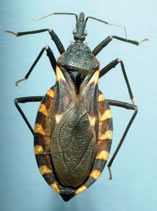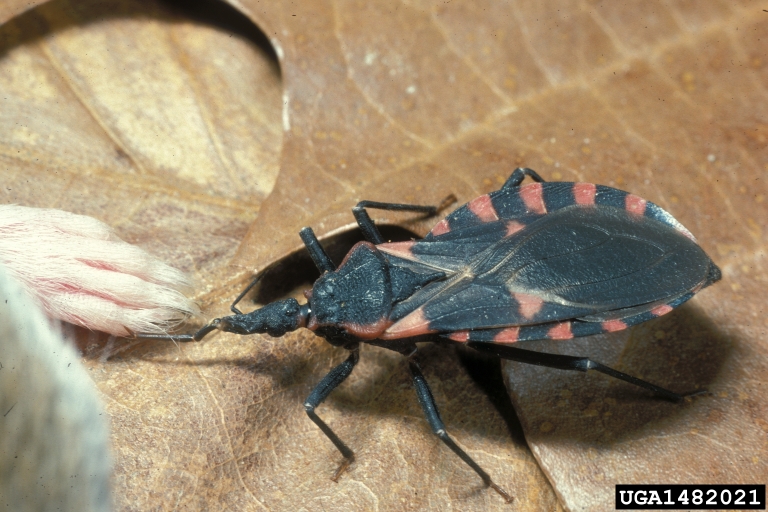 Conenose Bugs - May 11, 2016 Jeff Schalau, Agent, Agriculture & Natural Resources University of Arizona Cooperative Extension, Yavapai County Conenose bugs (Triatoma sp.) are also known as kissing bugs or Hualapai tigers and feed on the blood of mammals. Their primary hosts are rodents and most commonly wood rats (pack rats). They will also feed on human hosts when others are not available. They tend to be most prevalent in foothill areas of mountains and on the edges of towns where wood rats and ground squirrels are most abundant. Four species of conenose bugs occur in Arizona. Adults are ˝ to 1 inch (15 mm) long, brownish black, broad, flat, but stout-bodied, with six reddish orange spots on each side of the abdomen, above and below. It has an elongated, cone-shaped head, hence its name. The beak is slender and tapered and almost bare. Its wings are normally folded across the back while resting or crawling and not usually noticed by the casual observer (see photo with the online edition). Conenose bugs usually feed when the host organism is sleeping. Most people do not feel the bite of the conenose bug but may find an engorged bug in their bed. Usually there are multiple punctures about 1/4 inch apart along a straight line primarily on the torso; the bite is initially painless but may swell and cause a substantial welt that itches for several days. Fifty percent of those bitten react more severely the second time, with symptoms ranging from welts that itch to swelling of the tongue, larynx, and trachea. If you suspect that you have been bitten by a conenose bug and are experiencing an allergic reaction, call your local poison control center immediately (the Arizona Poison Control Center phone number is 800-222-1222). Conenose bugs fly from rodent burrows in late spring to early summer to search for new rodent burrows. They fly at night and are attracted to lights. They may also fly toward outdoor lighting or windows with light showing. If the home is not well screened and weather stripped, they may easily gain entry to feed on humans and pets. They also can move from rodents to human hosts when rodents are suddenly removed from the area. If you decide to remove a wood rat nest, be sure to treat it with an insecticide (as well as with an antiviral disinfectant to reduce risk of Hanta virus). They may also be found in and near swallow nests. There are several steps to prevent conenose bugs from entering your home. In addition to weather stripping, caulking, screening vents and otherwise sealing the home, you can: have packrat nests within 300 feet of the home removed; reduce the amount and duration of outdoor lighting; use yellow “bug bulbs” that do not attract insects; use shades or curtains on brightly lit windows; check bedding, furniture, and under beds; and in extreme cases, bed nets can be used. If you decide to use an insecticide, use a crack and crevice formula and treat any areas where conenose bugs could hide. Also, be cautious when camping to minimize risk of conenose bites. Don’t camp near wood rat nests, ground squirrel colonies, or caves when adults are active in the summer months. In Latin America, some species of conenose bugs transmit the organism that causes Chagas’ disease. Two cases of Chagas’ disease have been reported in southern Texas and one in central California. The Chagas’ disease protozoan, Trypanosoma cruzi, is transmitted by conenose bugs when it is excreted in their feces. If the fecal material is scratched into the bite or onto mucous membranes, it can enter the human body; therefore, always disinfect the bite site with iodine to prevent infection, and then wash it to remove fecal material. Latin American conenose bug species are more likely to defecate after feeding making the disease more common there. Immediate symptoms of Chagas’ disease include swelling of the face, high or moderate fever two weeks after being bitten, swelling of other body areas, and sometimes nervous disorders. Other more serious disorders can also develop if a chronic infection develops. Do not get freaked out over conenose bugs. Learn to identify and exclude them from your home. They are one of many wild inhabitants that live near us and can invade our space from time to time. Educate yourself and be vigilant. Follow the Backyard Gardener on Twitter – use the link on the BYG website. If you have other gardening questions, call the Master Gardener help line in the Camp Verde office at 928-554-8992 or e-mail us at verdevalleymg@gmail.com and be sure to include your name, address and phone number. Find past Backyard Gardener columns or provide feedback at the Backyard Gardener web site: http://cals.arizona.edu/yavapai/anr/hort/byg/.  Additional Resources How to Bug Proof Your Home: Conenose Bugs eXtension.org articles.extension.org/pages/21014/how-to-bug-proof-your-home:-conenose-bugs Conenose or Kissing Bugs Texas A & M AgriLife Extension citybugs.tamu.edu/factsheets/biting-stinging/others/ent-3008/ Conenose Bugs University of California Integrated Pest Management www.ipm.ucdavis.edu/PMG/PESTNOTES/pn7455.html |